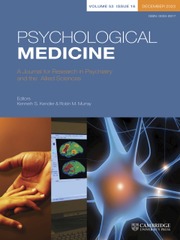Crossref Citations
This article has been cited by the following publications. This list is generated based on data provided by
Crossref.
Bolhuis, Koen
Viding, Essi
Muetzel, Ryan L.
El Marroun, Hanan
Kocevska, Desana
White, Tonya
Tiemeier, Henning
and
Cecil, Charlotte A.M.
2019.
Neural Profile of Callous Traits in Children: A Population-Based Neuroimaging Study.
Biological Psychiatry,
Vol. 85,
Issue. 5,
p.
399.
2019.
Vol. 93,
Issue. ,
p.
169.
Huang, Yonglin
Wu, Tingting
Gao, Yu
Luo, Yuyang
Wu, Ziyan
Fagan, Shawn
Leung, Stephanie
and
Li, Xiaobo
2019.
The Impact of Callous-Unemotional Traits and Externalizing Tendencies on Neural Responsivity to Reward and Punishment in Healthy Adolescents.
Frontiers in Neuroscience,
Vol. 13,
Issue. ,
2020.
Sex Differences in Neurology and Psychiatry.
Vol. 175,
Issue. ,
p.
405.
Rhoads, Shawn A.
Cardinale, Elise M.
O’Connell, Katherine
Palmer, Amy L.
VanMeter, John W.
and
Marsh, Abigail A.
2020.
Mapping neural activity patterns to contextualized fearful facial expressions onto callous-unemotional (CU) traits: intersubject representational similarity analysis reveals less variation among high-CU adolescents.
Personality Neuroscience,
Vol. 3,
Issue. ,
Waller, Rebecca
Hawes, Samuel W.
Byrd, Amy L.
Dick, Anthony S.
Sutherland, Matthew T.
Riedel, Michael C.
Tobia, Michael J.
Bottenhorn, Katherine L.
Laird, Angela R.
and
Gonzalez, Raul
2020.
Disruptive Behavior Problems, Callous-Unemotional Traits, and Regional Gray Matter Volume in the Adolescent Brain and Cognitive Development Study.
Biological Psychiatry: Cognitive Neuroscience and Neuroimaging,
Vol. 5,
Issue. 5,
p.
481.
Cardinale, Elise M.
2020.
Parsing Comorbidity: The Challenge of Studying Neurobiological Correlates of Callous-Unemotional Traits.
Biological Psychiatry: Cognitive Neuroscience and Neuroimaging,
Vol. 5,
Issue. 5,
p.
470.
Naaijen, Jilly
Mulder, Leandra M
Ilbegi, Shahrzad
de Bruijn, Sanne
Kleine-Deters, Renee
Dietrich, Andrea
Hoekstra, Pieter J
Marsman, Jan-Bernard C
Aggensteiner, Pascal M
Holz, Nathalie E
Boettinger, Boris
Baumeister, Sarah
Banaschewski, Tobias
Saam, Melanie C
M E Schulze, Ulrike
Santosh, Paramala J
Sagar-Ouriaghli, Ilyas
Mastroianni, Mathilde
Castro Fornieles, Josefina
Bargallo, Nuria
Rosa, Mireia
Arango, Celso
Penzol, Maria J
Werhahn, Julia E
Walitza, Susanne
Brandeis, Daniel
Glennon, Jeffrey C
Franke, Barbara
Zwiers, Marcel P
and
Buitelaar, Jan K
2020.
Specific cortical and subcortical alterations for reactive and proactive aggression in children and adolescents with disruptive behavior.
NeuroImage: Clinical,
Vol. 27,
Issue. ,
p.
102344.
Ling, Shichun
Raine, Adrian
Waller, Rebecca E.
Ruparel, Kosha
Loughead, James
and
Gur, Ruben C.
2020.
Divergent Amygdala Volume Asymmetries for Male and Female Youth With High Versus Low Callous-Unemotional Traits.
Crime & Delinquency,
Vol. 66,
Issue. 10,
p.
1419.
Drabick, Deborah A. G.
Jakubovic, Rafaella J.
Everett, Valerie S.
Friedman, Abbey L.
Emory, George O.
and
Kalchthaler, Faylyn B.
2021.
Conduct problems among children in low-income, urban neighborhoods: A developmental psychopathology- and RDoC-informed approach.
Development and Psychopathology,
Vol. 33,
Issue. 5,
p.
1864.
Deng, Jiaxin
Wang, Meng‐Cheng
Shou, Yiyun
and
Gao, Yu
2021.
Core features of callous–unemotional traits: Network analysis of the inventory of callous–unemotional traits in offender and community samples.
Journal of Clinical Psychology,
Vol. 77,
Issue. 6,
p.
1487.
De Brito, Stephane A.
Forth, Adelle E.
Baskin-Sommers, Arielle R.
Brazil, Inti A.
Kimonis, Eva R.
Pardini, Dustin
Frick, Paul J.
Blair, Robert James R.
and
Viding, Essi
2021.
Psychopathy.
Nature Reviews Disease Primers,
Vol. 7,
Issue. 1,
Winters, Drew E.
Sakai, Joseph T.
and
Carter, R. McKell
2021.
Resting-state network topology characterizing callous-unemotional traits in adolescence.
NeuroImage: Clinical,
Vol. 32,
Issue. ,
p.
102878.
Umbach, Rebecca H.
and
Tottenham, Nim
2021.
Callous-unemotional traits and reduced default mode network connectivity within a community sample of children.
Development and Psychopathology,
Vol. 33,
Issue. 4,
p.
1170.
Krueger, Robert F.
Hobbs, Kelsey A.
Conway, Christopher C.
Dick, Danielle M.
Dretsch, Michael N.
Eaton, Nicholas R.
Forbes, Miriam K.
Forbush, Kelsie T.
Keyes, Katherine M.
Latzman, Robert D.
Michelini, Giorgia
Patrick, Christopher J.
Sellbom, Martin
Slade, Tim
South, Susan C.
Sunderland, Matthew
Tackett, Jennifer
Waldman, Irwin
Waszczuk, Monika A.
Wright, Aidan G.C.
Zald, David H.
Watson, David
and
Kotov, Roman
2021.
Validity and utility of Hierarchical Taxonomy of Psychopathology (HiTOP): II. Externalizing superspectrum.
World Psychiatry,
Vol. 20,
Issue. 2,
p.
171.
Levantini, Valentina
Muratori, Pietro
Calderoni, Sara
Inguaggiato, Emanuela
Masi, Gabriele
Milone, Annarita
Tonacci, Alessandro
and
Billeci, Lucia
2022.
Parenting practices moderate the link between attention to the eyes and callous unemotional traits in children with Disruptive Behavior Disorder: An eye-tracking study.
Journal of Psychiatric Research,
Vol. 146,
Issue. ,
p.
272.
Deming, Philip
Heilicher, Mickela
and
Koenigs, Michael
2022.
How reliable are amygdala findings in psychopathy? A systematic review of MRI studies.
Neuroscience & Biobehavioral Reviews,
Vol. 142,
Issue. ,
p.
104875.
Hodgins, Sheilagh
2022.
Textbook of Antisocial Personality Disorder.
p.
311.
Tkalcec, Antonia
Bierlein, Maria
Seeger‐Schneider, Gudrun
Walitza, Susanne
Jenny, Bettina
Menks, Willeke M.
Felhbaum, Lynn V.
Borbas, Reka
Cole, David M.
Raschle, Nora
Herbrecht, Evelyn
Stadler, Christina
and
Cubillo, Ana
2023.
Empathy deficits, callous‐unemotional traits and structural underpinnings in autism spectrum disorder and conduct disorder youth.
Autism Research,
Vol. 16,
Issue. 10,
p.
1946.
Jiang, Yali
Gao, Yidian
Dong, Daifeng
Sun, Xiaoqiang
Situ, Weijun
and
Yao, Shuqiao
2023.
Structural abnormalities in adolescents with conduct disorder and high versus low callous unemotional traits.
European Child & Adolescent Psychiatry,
Vol. 32,
Issue. 1,
p.
193.

